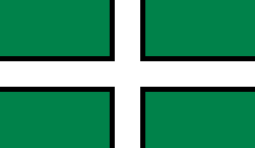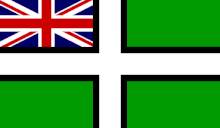Flag of Devon
 | |
| Saint Petroc's flag | |
| Use | Civil flag |
|---|---|
| Proportion | 3:5, also 25:43 (1:1.72) |
| Adopted | October 2006 (by county council) |
| Design | A centred white cross with black edging on green background. (Vert, a cross argent) |
| Designed by | Ryan Sealey |
The Flag of Devon (also known as St Petroc's Cross) is the flag of the ceremonial county of Devon. It is dedicated to Saint Petroc,[1] a local saint with numerous dedications throughout Devon. It is notable for its creation through two web-based polls.[2][3]
History
[edit]The subject of a Devonian flag was raised by the county's contingent of scouts to the 20th World Scout Jamboree in an interview on BBC Radio Devon in 2002. The scouts were unaware of a Devon flag and wondered if any listeners knew of a flag for the county. BBC Radio Devon took up the search for a flag for Devon and asked the public to send in designs.
The flag was chosen in 2003 after a vote in two polls run by the BBC Devon website, the winning design taking 49% of the votes cast. The design was created by student Ryan Sealey.[3]
The Devon Flag is made of three colours – green (Pantone 348), black and white.[1] Although the flag is relatively young, its colours are those traditionally identified with Devon[3] (e.g. the colours of its Rugby Union team, Exeter University and Plymouth Argyle F.C.). In 1816, Lord Exmouth flew a dark green flag with white circles at the Bombardment of Algiers,[4][5] now on view at the Teign Valley Museum.[4] The green represents the colour of the rolling and lush Devon hills, the black represents the high and windswept moors (Dartmoor and Exmoor) and the white represents both the salt spray of Devon's two coastlines and the China Clay industry (and mining in general).[6]

The Devon flag rapidly gained popularity and saw widespread adoption, gaining official recognition in October 2006 when Devon County Council raised the flag outside County Hall.[7]
In April 2004, a resident of Ottery St Mary in East Devon was threatened with legal action for flying the Devon flag in his back garden, as planning permission was required to fly non-national flags. Subsequently the then Minister for Housing, Keith Hill, said local authorities can officially "turn a blind eye" to the practice of flying the county flag from poles.[8] Devon County Council had previously announced its intention to defy the government's flag-flying rules, continuing to fly the flag from council buildings.[9]
Devon ensign
[edit]
First flown in 2003, the Devon Regatta Ensign (designed by Kevin Pyne) adds a Union Flag into the Canton of the Devon Flag. This flag is described as for use at regatta, high days and holidays, weddings, and burials at sea.[10][11]
Flying the Devon flag
[edit]The Devon Flag Group have suggested the following dates as days when it is appropriate for the Devon flag to be flown. Most of them are either the days of local events or the feast days of Devon's saints. It is also flown outside of these days, especially in rural towns.[12]
- 4 January – St Rumon of Tavistock and Romansleigh
- 7 January – St Brannock of Braunton
- 5 March – St Piran, patron saint of tin miners
- 12 March – Paul Aurelian, brother of St Sidwell
- 7 April – St Brannock, as celebrated in Exeter
- 1 May – Saint Walpurga of Devon
- May Bank Holiday – anniversary of first time the flag was flown at World Gig Championship 2003, Isles of Scilly
- May/June – Devon County Show
- 3 June – St Kevin
- 4 June – St Petroc
- 5 June – St Boniface of Crediton, Patron Saint of Devon
- 6 June – St Gudwal, hermit of Devon
- 17 June – St Nectan, patron of Hartland
- 21/22 June – Midsummer's day
- 26 June – St Brannock - another feast day
- 5 July – Exeter Lammas Fair
- 8 July – St Urith of Chittlehampton
- 13 July – St Juthware
- 30 July – anniversary of battle against Spanish Armada
- 1 August – St Sidwell, Patron Saint of Exeter
- 10 August – St Geraint Last King of Dumnonia
- 30 August – St Rumon
- 26 September – anniversary of Sir Francis Drake's Circumnavigation of the World
- 2 November – St Cumgar
- 5 November – St Kea
- 7 November – St Congar
- 8 December – St Budoc (St Budeaux) of Plymouth
- 12 December – St Corentin
- 16 December – Saint Judicael, King of Domnonée
- 21/22 December – Midwinter
- 31 Dec to 6 Jan – New Year's Eve to Twelfth Night
Controversy
[edit]The creation of the flag drew criticism from Cornish nationalists, who accused it online of being an attempt to "hijack" their culture.[13]
Bob Burns, who started the discussion over a flag for Devon, cited the visibility of the Cornish Flag as one of his reasons "Devonians are only too aware of the ubiquitous Cornish Flag, which can often be seen in the form of car bumper stickers, on vehicles entering Devon from Cornwall."[3]
Dr Mark Stoyle, a Devon historian, noted that "People are quite aware in Devon that the Cornish make political capital by claiming to be different". He also suggested that the new-found sense of Devonian identity was a backlash against incoming "city-dwellers settling in the South West".[13]
The decision to dedicate the flag to St Petroc was not without controversy as the saint is equally popular in neighbouring Cornwall. In defending the decision, Devon's strong claim to the saint was highlighted – Devon's 27 church dedications to Saint Petroc outnumber the 6 dedications in Cornwall, and a great many Devon villages are named after the Saint, such as Petrockstowe and Newton St Petroc. Cornwall had already selected Saint Piran as their patron saint many years previously.
See also
[edit]References
[edit]- ^ a b The Flag Institute
- ^ "Devon, England". Flags of the world. 21 October 2011. Retrieved 28 May 2016.
- ^ a b c d "Flag celebrates Devon's heritage". BBC Devon. January 2005. Retrieved 25 January 2014.
- ^ a b "Pellew". Teign Heritage. Retrieved 23 August 2020.
- ^ "Devon". British County Flags. 17 July 2013. Retrieved 23 August 2020.
- ^ "Devon Flag Group". Devon County Council website. Archived from the original on 6 January 2015. Retrieved 4 February 2015.
- ^ "Devon Flag". Devon County Council website. Archived from the original on 1 February 2014. Retrieved 25 January 2014.
- ^ "Council's told they can "turn a blind eye" to flag flying". BBC Devon. December 2004. Retrieved 25 January 2014.
- ^ "Council to defy flag-flying rules". BBC NEWS. 3 August 2006. Retrieved 22 September 2024.
- ^ "Flags of Empire: Ensigns of the Home Nations and Europe".
- ^ "Devon (England)".
- ^ "When to fly the flag". Devon County Council website. Archived from the original on 1 February 2014. Retrieved 25 January 2014.
- ^ a b "New Flag Causes A Flap in South West". BBC Devon. Retrieved 13 September 2008.
